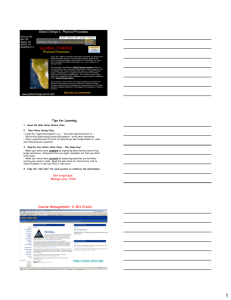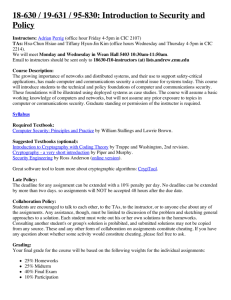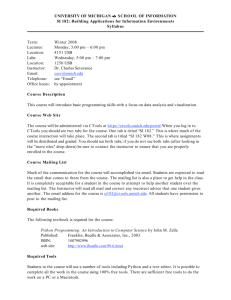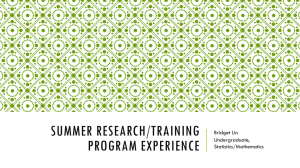Biostatistics 581 Biostatistical Modeling in Clinical Research Course
advertisement
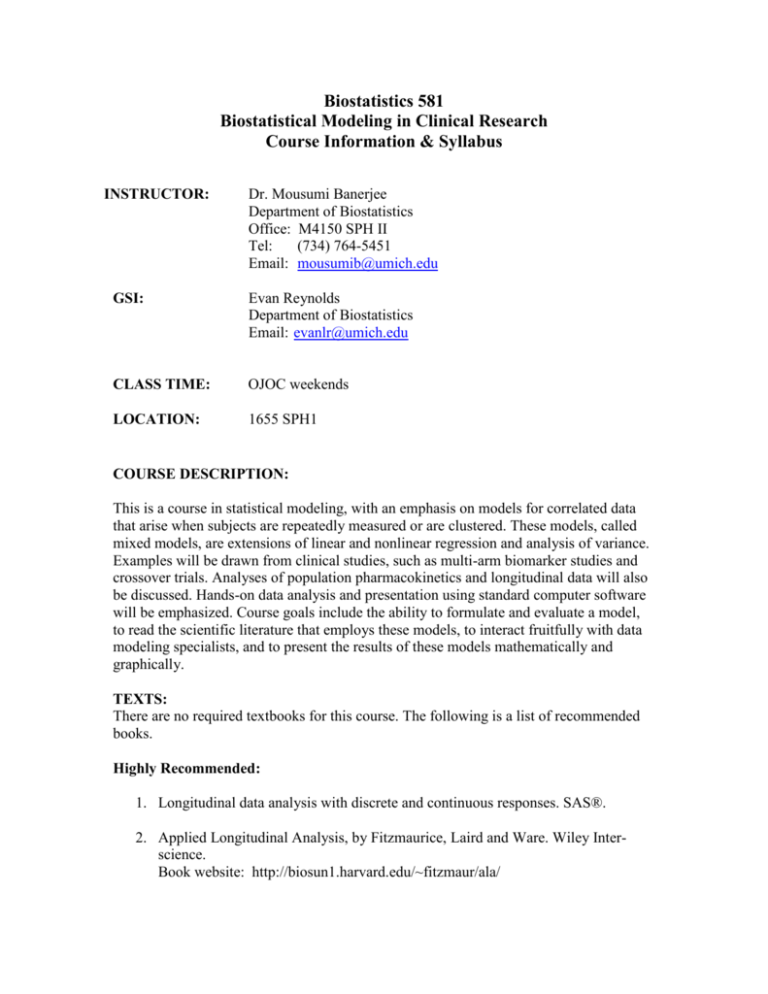
Biostatistics 581 Biostatistical Modeling in Clinical Research Course Information & Syllabus INSTRUCTOR: Dr. Mousumi Banerjee Department of Biostatistics Office: M4150 SPH II Tel: (734) 764-5451 Email: mousumib@umich.edu GSI: Evan Reynolds Department of Biostatistics Email: evanlr@umich.edu CLASS TIME: OJOC weekends LOCATION: 1655 SPH1 COURSE DESCRIPTION: This is a course in statistical modeling, with an emphasis on models for correlated data that arise when subjects are repeatedly measured or are clustered. These models, called mixed models, are extensions of linear and nonlinear regression and analysis of variance. Examples will be drawn from clinical studies, such as multi-arm biomarker studies and crossover trials. Analyses of population pharmacokinetics and longitudinal data will also be discussed. Hands-on data analysis and presentation using standard computer software will be emphasized. Course goals include the ability to formulate and evaluate a model, to read the scientific literature that employs these models, to interact fruitfully with data modeling specialists, and to present the results of these models mathematically and graphically. TEXTS: There are no required textbooks for this course. The following is a list of recommended books. Highly Recommended: 1. Longitudinal data analysis with discrete and continuous responses. SAS®. 2. Applied Longitudinal Analysis, by Fitzmaurice, Laird and Ware. Wiley Interscience. Book website: http://biosun1.harvard.edu/~fitzmaur/ala/ Recommended: 1. Modeling Longitudinal Data, by Weiss. Springer. COMPUTING: Upon entering the course, students are expected to have basic skills in statistical programming (e.g. reading in data, creating new variables, merging data sets, case selection, subsetting, sorting, stratification, etc.). Software examples used in the course will be in SAS. The choice of statistical software for course assignments is yours, but support from the instructor will only be given in SAS. Students are strongly encouraged to visit the UCLA website for statistical computing, which gives many examples on data coding, and explanations of software outputs. http://www.ats.ucla.edu/stat http://www.ats.ucla.edu/stat/sas/default.htm CLASS WEBPAGE: Available on CTools: https://ctools.umich.edu/ All lecture notes, handouts, homework assignments, their solutions, and various other help materials for the course will be posted on the course website on a regular basis throughout the semester. Please bring your own downloaded copy of the lecture notes to each lecture. HOMEWORKS: There will be regular homework assignments, covering theoretical material, applications, data analysis using statistical software, and interpretation of results. Submit hardcopies of your homework, with the sheets stapled together provided there is more than one page. Relevant parts of computer outputs should be attached where necessary. An un-annotated computer output will not constitute an acceptable answer. It is advisable to present a report-style integration of written answers and computer printouts by a “cut-and-paste” job if necessary. You may work on homework problem sets in groups; however the write-up and interpretations must be your own work. Any form of copying from another person’s work will be construed as violation of academic conduct and will be subject to appropriate disciplinary actions as per university rules. Late assignments will be assessed a penalty of 20% for each day late, so you are encouraged to submit them on time. No late homeworks will be accepted after the solutions have been posted. COURSE EVALUATION: Homeworks: 40% Midterm: 20% Final Project: 40% ACADEMIC INTEGRITY: The faculty of the School of Public Health believes that the conduct of a student registered or taking courses in the School should be consistent with that of a professional person. Courtesy, honesty and respect should be shown by students toward faculty memebers, guest lecturers, administrative support staff and fellow students. Similarly, students should expect faculty to treat them fairly, showing respect for their ideas and opinions and striving to help them achieve maximum benefits from their experience in the School. Student academic misconduct refers to behavior that may include plagiarism, cheating, fabrication, falsification of records or official documents, intentional misuse of equipment or materials (including library materials), and aiding and abetting the perpetration of such acts. The preparation of reports, papers, and examinations, assigned on an individual basis, must represent each student’s own effort. Reference sources should be indicated clearly. The use of assistance from other students or aids of any kind during a written examination, except when the use of aids such as electronic devices, books or notes has been approved by an instructor, is a violation of the standard of academic conduct.
